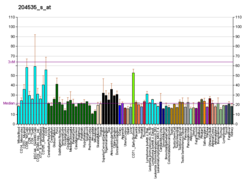REST (タンパク質)
REST(RE1 silencing transcription factor)またはNRSF(neuron-restrictive silencer factor)は、転写リプレッサーとして機能するタンパク質であり、ヒトではREST遺伝子によってコードされている[5][6][7]。RESTは神経以外の細胞において神経関連遺伝子の抑制に関与している[7][8]。切り詰めれらたRESTタンパク質が観察される結腸がんや小細胞肺がんなど、RESTの発現パターンの変化は多くの疾患と関連づけられている[9]。こうしたがん以外にも、RESTの欠陥はハンチントン病や神経芽腫、てんかん発作や虚血の影響とも関係している。
機能
[編集]RESTは、神経以外の組織において神経関連遺伝子を抑制する転写リプレッサーであり、KLFファミリーに属するジンクフィンガー型転写因子である。NRSE(neuron-restrictive silencer element、もしくはRE1)と呼ばれるDNA配列エレメントに結合することで転写を抑制する。このタンパク質は未分化の神経前駆細胞にも存在し、神経発生のマスターネガティブレギュレーターとして作用している可能性が考えられている[5]。RESTには8つのCys2His2型ジンクフィンガーが存在し、いくつかのクロマチン修飾酵素をリクルートすることで遺伝子の抑制を媒介している[10]。
RESTはアルツハイマー病の高齢者でダウンレギュレーションされていることが知られている[11]。
また脳虚血のマウスモデルでは、RESTは虚血誘発性の神経細胞死を媒介する。虚血は組織への血液の灌流の低下を原因とし、栄養素や酸素の供給低下が引き起こされた状態である。RESTは虚血によって誘導されて核内に蓄積し、神経遺伝子のエピジェネティックな抑制によって神経死をもたらす[12]。低酸素時のRESTの核内移行と低酸素依存的な遺伝子発現抑制は密接に関連している可能性があり、RESTは低酸素状態における遺伝子抑制のマスターレギュレーターとしての機能を果たしていると考えられる[13]。
相互作用
[編集]RESTはRCOR1と相互作用することが示されている[14]。
出典
[編集]- ^ a b c GRCh38: Ensembl release 89: ENSG00000084093 - Ensembl, May 2017
- ^ a b c GRCm38: Ensembl release 89: ENSMUSG00000029249 - Ensembl, May 2017
- ^ Human PubMed Reference:
- ^ Mouse PubMed Reference:
- ^ a b “Entrez Gene: REST RE1-silencing transcription factor”. 2024年11月4日閲覧。
- ^ “The neuron-restrictive silencer factor (NRSF): a coordinate repressor of multiple neuron-specific genes”. Science 267 (5202): 1360–3. (March 1995). Bibcode: 1995Sci...267.1360S. doi:10.1126/science.7871435. PMID 7871435.
- ^ a b “REST: a mammalian silencer protein that restricts sodium channel gene expression to neurons”. Cell 80 (6): 949–57. (March 1995). doi:10.1016/0092-8674(95)90298-8. PMID 7697725.
- ^ “Transcriptional regulation: cancer, neurons and the REST”. Current Biology 15 (17): R665–8. (September 2005). Bibcode: 2005CBio...15.R665C. doi:10.1016/j.cub.2005.08.032. PMID 16139198.
- ^ “A genetic screen for candidate tumor suppressors identifies REST”. Cell 121 (6): 837–48. (June 2005). doi:10.1016/j.cell.2005.03.033. PMID 15960972.
- ^ “Chromatin crosstalk in development and disease: lessons from REST”. Nature Reviews Genetics 8 (7): 544–54. (July 2007). doi:10.1038/nrg2100. PMID 17572692.
- ^ “REST and stress resistance in ageing and Alzheimer's disease”. Nature 507 (7493): 448–54. (March 2014). Bibcode: 2014Natur.507..448L. doi:10.1038/nature13163. PMC 4110979. PMID 24670762.
- ^ “Repressor element-1 silencing transcription factor (REST)-dependent epigenetic remodeling is critical to ischemia-induced neuronal death”. Proceedings of the National Academy of Sciences of the United States of America 109 (16): E962–71. (April 2012). doi:10.1073/pnas.1121568109. PMC 3341013. PMID 22371606.
- ^ “REST is a hypoxia-responsive transcriptional repressor”. Scientific Reports 6: 31355. (17 Aug 2016). Bibcode: 2016NatSR...631355C. doi:10.1038/srep31355. PMC 4987654. PMID 27531581.
- ^ “CoREST: a functional corepressor required for regulation of neural-specific gene expression”. Proceedings of the National Academy of Sciences of the United States of America 96 (17): 9873–8. (August 1999). Bibcode: 1999PNAS...96.9873A. doi:10.1073/pnas.96.17.9873. PMC 22303. PMID 10449787.
関連文献
[編集]- “Chromatin crosstalk in development and disease: lessons from REST”. Nature Reviews Genetics 8 (7): 544–54. (July 2007). doi:10.1038/nrg2100. PMID 17572692.
- “REST: a mammalian silencer protein that restricts sodium channel gene expression to neurons”. Cell 80 (6): 949–57. (March 1995). doi:10.1016/0092-8674(95)90298-8. PMID 7697725.
- “The neuron-restrictive silencer factor (NRSF): a coordinate repressor of multiple neuron-specific genes”. Science 267 (5202): 1360–3. (March 1995). Bibcode: 1995Sci...267.1360S. doi:10.1126/science.7871435. PMID 7871435.
- “A zinc finger protein that represses transcription of the human MHC class II gene, DPA”. Journal of Immunology 156 (4): 1448–57. (February 1996). doi:10.4049/jimmunol.156.4.1448. PMID 8568247.
- “Transcriptional regulation: cancer, neurons and the REST”. Current Biology 15 (17): R665–8. (September 2005). Bibcode: 2005CBio...15.R665C. doi:10.1016/j.cub.2005.08.032. PMID 16139198.
- “Biological activity and modular structure of RE-1-silencing transcription factor (REST), a repressor of neuronal genes”. The Journal of Biological Chemistry 273 (41): 26891–9. (October 1998). doi:10.1074/jbc.273.41.26891. PMID 9756936.
- “CoREST: a functional corepressor required for regulation of neural-specific gene expression”. Proceedings of the National Academy of Sciences of the United States of America 96 (17): 9873–8. (August 1999). Bibcode: 1999PNAS...96.9873A. doi:10.1073/pnas.96.17.9873. PMC 22303. PMID 10449787.
- “Neuron-specific splicing of zinc finger transcription factor REST/NRSF/XBR is frequent in neuroblastomas and conserved in human, mouse and rat”. Brain Research. Molecular Brain Research 72 (1): 30–9. (September 1999). doi:10.1016/S0169-328X(99)00196-5. PMID 10521596.
- “Neural restrictive silencer factor recruits mSin3 and histone deacetylase complex to repress neuron-specific target genes”. Proceedings of the National Academy of Sciences of the United States of America 96 (24): 13691–6. (November 1999). Bibcode: 1999PNAS...9613691N. doi:10.1073/pnas.96.24.13691. PMC 24126. PMID 10570134.
- “The co-repressor mSin3A is a functional component of the REST-CoREST repressor complex”. The Journal of Biological Chemistry 275 (13): 9461–7. (March 2000). doi:10.1074/jbc.275.13.9461. PMID 10734093.
- “A splice variant of the neuron-restrictive silencer factor repressor is expressed in small cell lung cancer: a potential role in derepression of neuroendocrine genes and a useful clinical marker”. Cancer Research 60 (7): 1840–4. (April 2000). PMID 10766169.
- “Cell-type non-selective transcription of mouse and human genes encoding neural-restrictive silencer factor”. Brain Research. Molecular Brain Research 90 (2): 174–86. (June 2001). doi:10.1016/S0169-328X(01)00107-3. PMID 11406295.
- “REST repression of neuronal genes requires components of the hSWI.SNF complex”. The Journal of Biological Chemistry 277 (43): 41038–45. (October 2002). doi:10.1074/jbc.M205691200. PMID 12192000.
- “Corepressor-dependent silencing of chromosomal regions encoding neuronal genes”. Science 298 (5599): 1747–52. (November 2002). Bibcode: 2002Sci...298.1747L. doi:10.1126/science.1076469. PMID 12399542.
- “RE-1 silencing transcription factor (REST) regulates human synaptophysin gene transcription through an intronic sequence-specific DNA-binding site”. European Journal of Biochemistry 270 (1): 2–9. (January 2003). doi:10.1046/j.1432-1033.2003.03360.x. PMID 12492469.
- “Regulation of cholinergic gene expression by the neuron restrictive silencer factor/repressor element-1 silencing transcription factor”. Life Sciences 72 (18–19): 2021–8. (March 2003). doi:10.1016/S0024-3205(03)00065-1. PMID 12628452.
- “Regulation of Pax4 paired homeodomain gene by neuron-restrictive silencer factor”. The Journal of Biological Chemistry 278 (37): 35057–62. (September 2003). doi:10.1074/jbc.M305891200. PMID 12829700.
- “Huntingtin interacts with REST/NRSF to modulate the transcription of NRSE-controlled neuronal genes”. Nature Genetics 35 (1): 76–83. (September 2003). doi:10.1038/ng1219. PMID 12881722.
- “Critical role of the transcriptional repressor neuron-restrictive silencer factor in the specific control of connexin36 in insulin-producing cell lines”. The Journal of Biological Chemistry 278 (52): 53082–9. (December 2003). doi:10.1074/jbc.M306861200. PMID 14565956.
- “NRSF regulates the fetal cardiac gene program and maintains normal cardiac structure and function”. The EMBO Journal 22 (23): 6310–21. (December 2003). doi:10.1093/emboj/cdg601. PMC 291842. PMID 14633990.
- “A small modulatory dsRNA specifies the fate of adult neural stem cells”. Cell 116 (6): 779–93. (March 2004). doi:10.1016/S0092-8674(04)00248-X. PMID 15035981.
- “Regulation of lifespan by neural excitation and REST”. Nature 574 (7778): 359–364. (October 2019). Bibcode: 2019Natur.574..359Z. doi:10.1038/s41586-019-1647-8. PMC 6893853. PMID 31619788.






